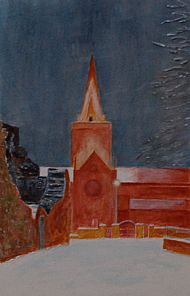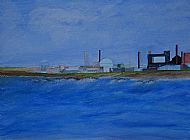 A Ship of the Line A ship of the line was a type of naval warship constructed from the 17th through to the mid-19th century to take part in the naval tactic known as the line of battle, in which two columns of opposing warships would manoeuvre to bring the greatest weight of broadside guns to bear. Since these engagements were almost invariably won by the heaviest ships carrying the most powerful guns, the natural progression was to build sailing vessels that were the largest and most powerful of their time |
|
 HMS Vanguard HMS Vanguard was a British fast battleship built during World War II and commissioned after the war. She was the only ship of her class and was the biggest, fastest and last of the Royal Navy's battleships and the final battleship to be launched in the world. Work on the ship's design commenced before the war because the Royal Navy anticipated being outnumbered by the combined German and Japanese battleships in the early 1940s. The existing Lion-class battleship design was modified to suit Vanguard's main armament. The British had enough guns and gun turrets in storage to allow one battleship to be built relatively quickly, but the work was started and stopped several times during the war. Even after construction had begun, her design was revised several times to reflect war experience, and these changes prevented her from being completed during the war. |
|
 The Mary Celeste The Mary Celeste (or Marie Céleste as it is fictionally referred to by Sir Arthur Conan Doyle and others after him) was a British-American merchant brigantine famous for having been discovered on 4 December 1872 in the Atlantic Ocean, unmanned and apparently abandoned (one lifeboat was missing, along with its crew of seven), although the weather was fine and her crew had been experienced and capable seamen. |
|
 Disused croft in a Corn Field This photograph was taken in September 2011 whilst we were over in Orkney for a holiday.
The croft in question can be found within the Birsay area - about three miles N/S of the Brough o Birsay. |
|
 Old boat at Talmine Bay Talmine is a crofting and fishing township, overlooking Talmine Bay, an inlet on the western shore of Tongue Bay in northern Sutherland, Scottish Highlands and is in the Scottish council area of Highland. |
|
 Le-Redoubtable on exercise
The Redoutable-class submarine is a ballistic missile submarine class of the French Marine Nationale. In French, the type is called Sous-marin Nucléaire Lanceur d'Engins (SNLE), literally "Missile-launching nuclear submarine". When commissioned, they constituted the strategic part of the naval component of the French nuclear triad, then called Force de frappe (the aircraft carriers Clemenceau and Foch constituting the tactical part).
|
|
 St. Magnus Cathedral - Kirkwall Orkney St. Magnus Cathedral, Kirkwall dominates the skyline of Kirkwall, the main town of Orkney, a group of islands off the north coast of mainland Scotland. It is the most northerly cathedral in the British Isles, a fine example of Romanesque architecture built for the bishops of Orkney when the islands were ruled by the Norse Earls of Orkney. It is owned not by the church, but by the burgh of Kirkwall as a result of an act of King James III of Scotland following Orkney's annexation by the Scottish Crown in 1468. It has its own dungeon. |
|
 Elvis Presley Elvis Aaron Presley (January 8, 1935 – August 16, 1977) was an American singer, musician, and actor. One of the most significant cultural icons of the 20th century, he is often referred to as "the King of Rock and Roll", or simply, "the King". |
|
 The Thurso Lifeboat This painting was first sketched and painted by using a photograph in our local newspaper in the early 1970s.
About 3 years later owing to the pressures of work - I decided to give up painting but now that I have retired and have taken up painting again - I find that I get a great deal of pleasure from it.
|
|
 Stalkers Cottage This painting came straight out of my mind and if I'm honest - I really enjoyed painting it.
The painting itself is meant to indicate the isolation that many gamekeepers find themselves having to endure. |
|
 This painting was created from a photograph that I took in the early 70s and depicts a sunset in Orkney. |
|
 Dounreay an Icon of the North Dounreay (Gaelic: Dùnrath) (Ordnance Survey grid reference NC982669) is on the north coast of Caithness, in the Highland area of Scotland. Dounreay was originally the site of a castle (now a ruin) and its name derives from the Gaelic for 'fort on a mound.
Since the 1950s it has been the site of several nuclear research establishments, including a prototype fast breeder reactor and a test for submarine reactors. Most of these facilities are now being decommissioned.
|
|
 Pier at John O Groats John o' Groats (Taigh Iain Ghròt in Scottish Gaelic) is a village in the Highland council area of Scotland. It is often called "The start of Great Britain" as John O'Groats is on the northeastern tip of Scotland.
Part of the county of Caithness, John o' Groats is popular with tourists because it is generally regarded as the most northerly settlement on the island of Great Britain, although this is not a claim made by its inhabitants and is in fact false.
It is however one end of the longest distance between two inhabited points on the island of Great Britain, Land's End being the other. John o' Groats is 876 miles (1409.78 km) away from Land's End. As Land's End is on the far southern end of Great Britain, the length of Great Britain is 876 miles long. (The most northerly point on the island of Great Britain is nearby Dunnet Head)
This painting was done in oils |
|
 Aspirant PD 510 The Aspirant PD 510 was a fishing vessel that sailed out of its home port of Aberdeen in Scotland – she cruised the local fishing grounds in which its crew earned their living by using her driftnets – the period that she would have been active is: 1908 - 1937 |
|
|
|
| |